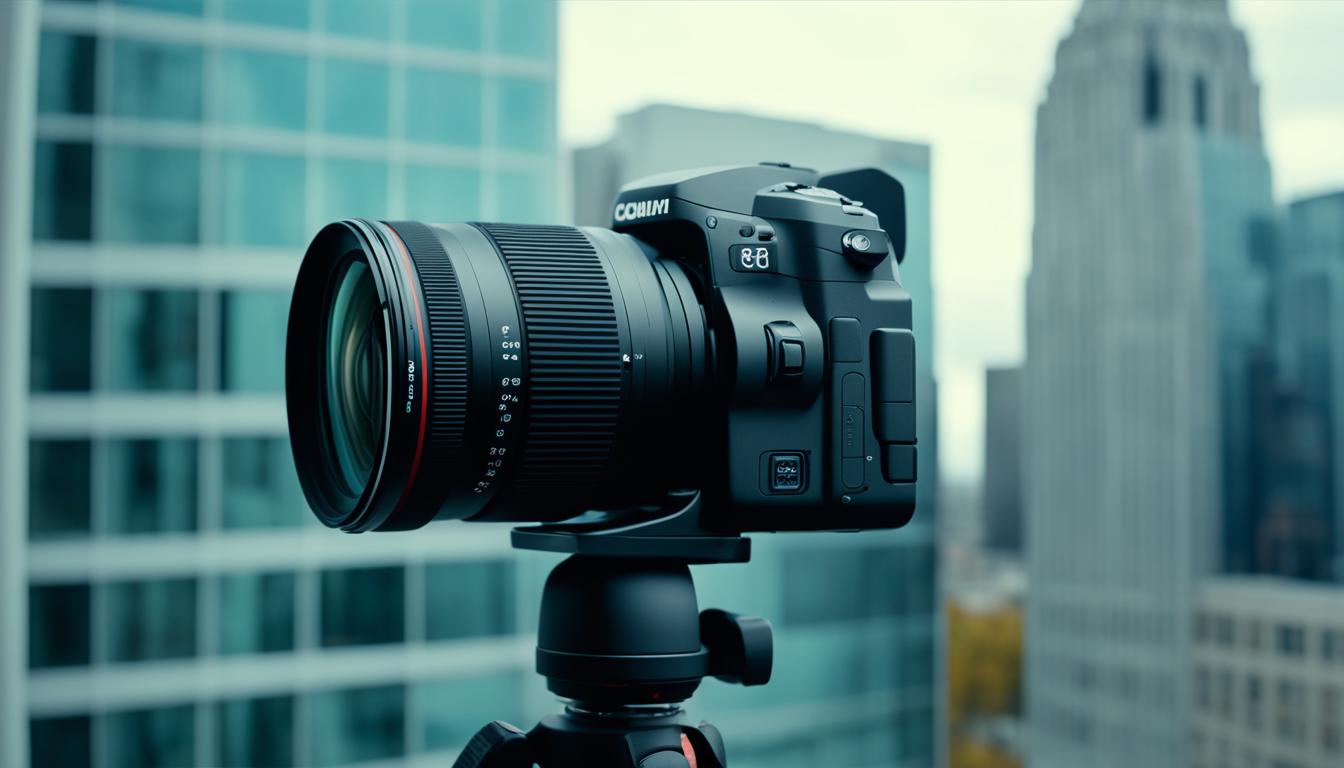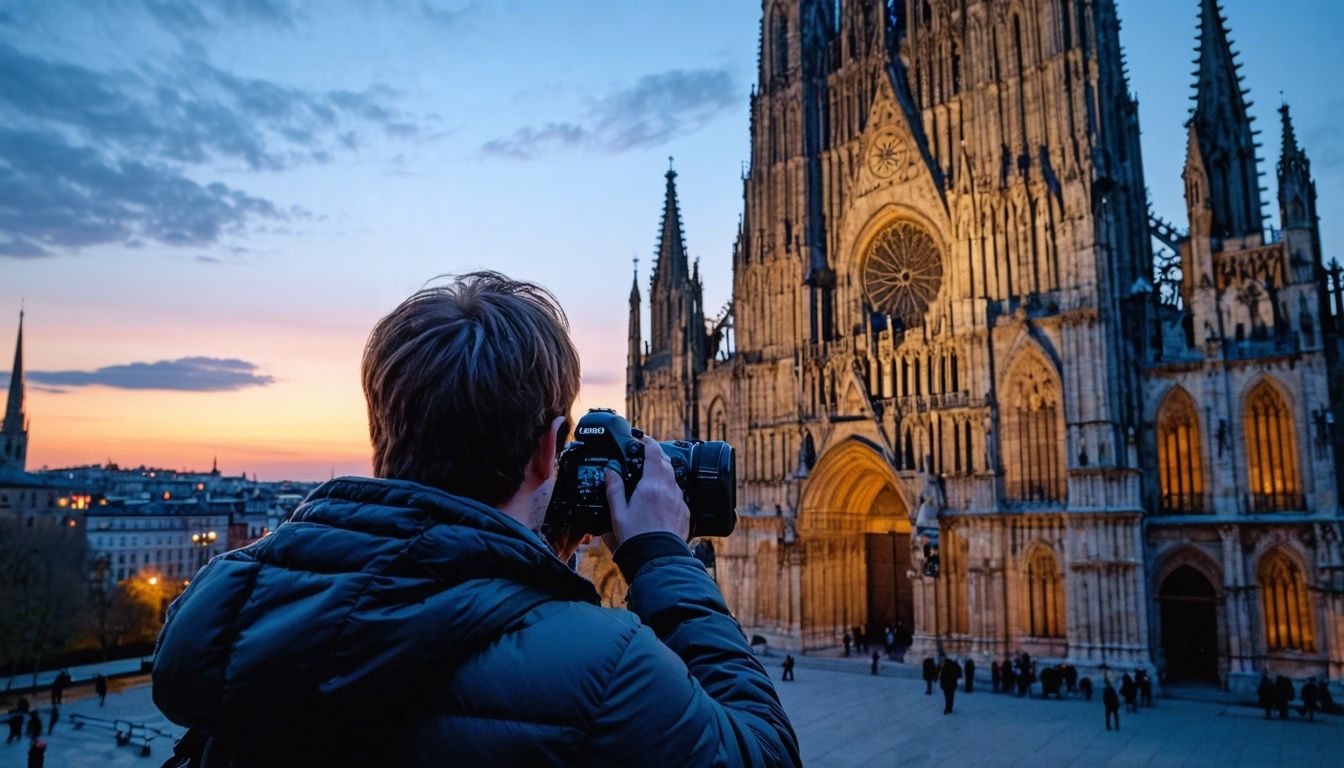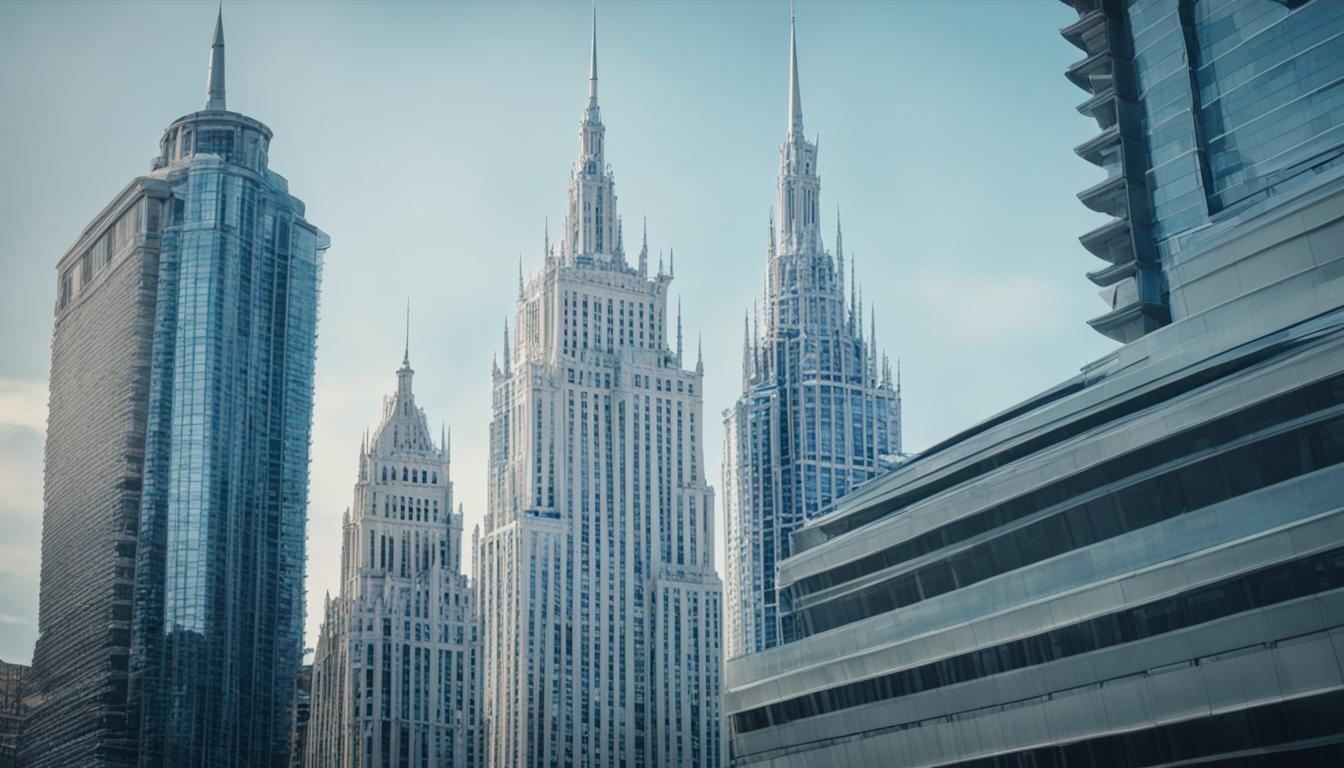Welcome to our comprehensive gear guide for architectural photography. Whether you’re a seasoned professional or just starting out, having the right equipment is vital for capturing stunning architectural shots. In this guide, we’ll explore the essential gear you need to elevate your architectural photography game to the next level.
Choosing the right equipment for architectural shots can be a daunting task, but fret not! We’re here to help you make informed decisions. From cameras to lenses and accessories, we’ll cover everything you need to know to create breathtaking architectural photographs that will leave a lasting impression.
Architectural photography gear comes in many shapes and sizes. We’ll discuss the best cameras for architecture photography, lens recommendations for architectural photography, and accessories that will enhance your creative process. Get ready to unlock your potential and capture the beauty of architecture like never before!
Key Takeaways:
- Choosing the right equipment is crucial for architectural photography.
- Invest in high-quality gear that suits your style and needs.
- Consider tilt-shift lenses or wide-angle lenses for perspective control.
- A sturdy tripod is essential for stability and control.
- Explore panorama heads and bubble levels for immersive shots and straight horizons.
Tilt-Shift Lens for Perspective Control
In the world of architectural photography, achieving accurate perspective control is essential for capturing stunning images. That’s where the tilt-shift lens comes into play. This remarkable piece of equipment allows us to take our architectural shots to the next level by offering unparalleled control over perspective and depth of field.
When using a tilt-shift lens, the image projected onto the camera’s sensor is larger than the sensor itself, allowing us to make precise adjustments. By shifting and tilting the lens, we can control the focus plane, eliminate converging lines, and eradicate the “falling backwards” effect that often plagues images of tall buildings.
Investing in a high-quality tilt-shift lens is crucial for any architecture photographer looking to capture stunning images. Here are some top recommendations:
| Tilt-Shift Lens | Maximum Aperture |
|---|---|
| Canon 17mm TS-E F/4L | F/4 |
| Canon 24mm TS-E F/3.5L II | F/3.5 |
| Nikon PC-E Nikkor 45mm f/2.8D | f/2.8 |
| Nikon PC-E Nikkor 85mm f/2.8D | f/2.8 |
These tilt-shift lenses offer exceptional build quality, precise control, and outstanding image quality, making them perfect companions for architecture photography.
Whether you’re photographing iconic landmarks or unique architectural structures, a tilt-shift lens is an indispensable tool that elevates your work to new heights. With its ability to manipulate perspective and depth of field, this lens empowers us to capture architectural shots that truly stand out.
Wide-Angle Lens for Perspective Control
When it comes to capturing stunning architectural photographs, a wide-angle lens can be a valuable asset, offering an alternative to tilt-shift lenses for perspective control. By shooting with the sensor surface parallel to the building and then cropping the image afterwards, you can eliminate the keystoning effect and achieve the desired perspective.
There are several wide-angle lenses that we recommend for architectural photography:
- Canon EF 17-40mm f/4L USM
- Fujifilm GF 30mm f/3.5 R WR Lens
- Sigma 16-28mm f/2.8 DG DN Contemporary Lens
- Sony FE 35mm f/1.4 GM Lens
- Zeiss 18mm f/2.8 Batis Series Lens
- Sony FE 20mm F1.8 G Lens
- Tamron 17-28mm f/2.8 Di III RXD Lens
These wide-angle lenses offer exceptional image quality and allow you to capture the full breadth of architectural structures while maintaining control over perspective. Whether you’re shooting towering skyscrapers or intricate architectural details, a wide-angle lens will provide you with the necessary versatility to create captivating photographs.
“A wide-angle lens opens up a whole new perspective, allowing you to showcase the grandeur and intricate details of architectural wonders. It’s like seeing the world through a different lens, revealing unique angles and dimensions.”
Pair your wide-angle lens with a sturdy tripod for added stability and explore the possibilities of architecture photography with a fresh wide-angle perspective.
Wide-Angle Lens Recommendations for Architecture Photography
| Wide-Angle Lens | Aperture | Compatibility | Price |
|---|---|---|---|
| Canon EF 17-40mm f/4L USM | f/4 | Canon DSLR | $799 |
| Fujifilm GF 30mm f/3.5 R WR Lens | f/3.5 | Fujifilm GFX | $1,699 |
| Sigma 16-28mm f/2.8 DG DN Contemporary Lens | f/2.8 | Canon EF-M, Sony E-mount, L-mount | $399 |
| Sony FE 35mm f/1.4 GM Lens | f/1.4 | Sony E-mount | $1,398 |
| Zeiss 18mm f/2.8 Batis Series Lens | f/2.8 | Sony E-mount | $1,399 |
| Sony FE 20mm F1.8 G Lens | f/1.8 | Sony E-mount | $898 |
| Tamron 17-28mm f/2.8 Di III RXD Lens | f/2.8 | Sony E-mount | $899 |
Choose the wide-angle lens that best suits your camera system and budget, and unlock a whole new dimension of perspective control in your architectural photography.

Tripod for Stability and Control
When it comes to architectural photography, stability and control are of utmost importance in capturing the perfect shot. That’s why a tripod is an essential piece of equipment for any architectural photographer.
Not only does a tripod provide stability, but it also allows for precise composition and eliminates camera shake, resulting in sharper images. This is especially crucial for longer exposures and low light conditions, where even the slightest movement can cause blurriness.
To help you find the ideal tripod for your architectural photography needs, we’ve rounded up some top recommendations:
| Tripod | Description |
|---|---|
| 3 Legged Thing Legends Ray 5-Section Carbon Fiber Travel Tripod | A lightweight and compact tripod that offers excellent stability, making it ideal for travel. |
| Manfrotto Befree Advanced Lever 4-Section Aluminum Travel Tripod | Designed for portability without compromising stability, this tripod is a great option for architectural photographers on the go. |
| Vanguard ALTA PRO 264AT 4-Section Aluminum Tripod | Featuring an innovative central column that can be tilted up to 180 degrees, this tripod allows for versatile positioning to capture unique angles. |
| Sachtler aktiv6 Sideload Fluid Head System with flowtech75 Tripod | This professional-grade tripod offers exceptional stability and smooth panning, perfect for architectural videography as well. |
| Manfrotto Element MII 4-Section Aluminum Tripod | An affordable option that doesn’t compromise on quality, this tripod provides reliable stability for your architectural shots. |
| Benro MeFOTO RoadTrip PRO Series 1 5-Section 6-In-1 Carbon Fiber Tripod | With its carbon fiber construction, this tripod combines lightweight portability with robust stability, making it a versatile choice for architectural photography. |
Investing in a high-quality tripod will not only enhance the stability and sharpness of your architectural shots but also provide you with greater control over your composition. With the right tripod, you can confidently capture every detail and create stunning architectural photographs.
Filters and Accessories for Architectural Photography
When it comes to architectural photography, having the right filters and accessories can take your shots to the next level. From capturing immersive panoramas to achieving accurate color reproduction, these tools are essential for professional architectural photographers. Let’s explore some of the must-have filters and accessories for architectural photography:
Panorama Head
A panorama head is a valuable tool for capturing wide-angle panoramas of architectural spaces. It allows you to smoothly rotate your camera on a tripod, ensuring seamless and immersive panoramic shots. Whether you’re shooting real estate properties or showcasing architectural masterpieces, a panorama head enhances the overall visual experience for your audience.
Bubble Level
Straight horizons are crucial in architectural photography, as any accidental diagonal horizons can significantly impact the overall composition. A bubble level helps you ensure that your horizons are perfectly straight and level. By attaching it to your camera’s hot shoe or tripod, you can achieve precise alignment and maintain the integrity of your architectural shots.
Color Calibration Systems
Accurate color reproduction is essential in architectural photography, especially when showcasing the subtle nuances of architectural details and materials. Color calibration systems, like X-Rite’s ColorChecker Passport or Datacolor’s SpyderX, help you achieve consistent and true-to-life colors in your images. By calibrating your camera and monitor, you can ensure that the colors accurately represent the architectural spaces you photograph.
Polarizing Filters
Reflections on windows and glossy surfaces can be challenging to manage in architectural photography. Polarizing filters help minimize these reflections and enhance the overall clarity of your architectural shots. By rotating the filter, you can adjust the level of polarization and eliminate unwanted glare, allowing viewers to focus on the architectural details without distractions.
Adobe Photoshop for Post-Processing
After capturing your architectural images, post-processing is essential to refine and enhance the final results. Adobe Photoshop is a powerful tool for architectural photographers, offering advanced editing features for fixing keystoning, adjusting colors, and optimizing the overall composition. With Photoshop’s array of tools and techniques, you can elevate the impact of your architectural shots and bring out their full potential.
Lighting Equipment
While natural light can create stunning effects in architectural photography, sometimes you need to supplement or control the lighting to achieve the desired results. Lighting equipment, such as studio lights, speedlights, and continuous lighting, can help you enhance the lighting conditions and highlight the architectural features. By strategically placing and adjusting the lights, you can create a dramatic ambiance and emphasize the unique design elements of each space.

Incorporating these filters and accessories into your architectural photography gear will allow you to capture stunning shots with precision and creative control. Whether you’re shooting expansive interiors, intricate architectural details, or breathtaking exteriors, these tools will help you showcase the beauty and grandeur of architectural spaces.
Conclusion
Choosing the right equipment is essential for capturing stunning architectural shots that exude professionalism. As architectural photographers, we understand the significance of having the right gear to achieve our desired results. From tilt-shift lenses and wide-angle lenses for perspective control to tripods for stability and bubble levels for ensuring straight horizons, each piece of equipment serves a crucial role in architectural photography.
To capture the grandeur of architectural spaces, panorama heads are valuable tools that allow us to create immersive panoramas. Additionally, color calibration setups aid in achieving accurate color reproduction, while polarizing filters help control reflections, enhancing the overall quality of our architectural shots.
In the realm of post-processing, Adobe Photoshop proves to be indispensable. It empowers us to fix keystone distortion and make precise adjustments to colors, elevating the final outcome of our architectural images. Furthermore, a range of lighting equipment, from studio lights to speedlights and continuous lighting, can significantly impact the lighting dynamics in architectural photography, resulting in visually stunning shots.
When it comes to architectural photography, we stress the importance of investing in high-quality gear that aligns with your unique needs and artistic style. By selecting the right equipment, you can capture architectural masterpieces with impeccable detail, depth, and perspective, solidifying your place as a skilled architectural photographer.
FAQ
What is the most important gear investment for architectural photography?
The most important gear investment for architectural photography is a Tilt-Shift lens, which allows for perspective control and depth of field.
Are there any alternatives to a Tilt-Shift lens for perspective control in architectural photography?
Yes, a wide-angle lens can be used as an alternative to a Tilt-Shift lens for perspective control in architectural photography.
Why is a tripod essential for architectural photography?
A tripod is essential for stability and control in architectural photography, particularly for longer exposures and capturing sharp images in low light conditions.
What are some recommended filters and accessories for architectural photography?
Recommended filters and accessories for architectural photography include panorama heads for capturing immersive panoramas, bubble levels for straight horizons, color calibration setups for accurate color reproduction, and polarizing filters for reflection control.
What are some recommended tilt-shift lenses for architectural photography?
Some recommended tilt-shift lenses for architectural photography include the Canon 17mm TS-E F/4L, Canon 24mm TS-E F/3.5L II, Nikon PC-E Nikkor 45mm f/2.8D, and Nikon PC-E Nikkor 85mm f/2.8D.
What are some recommended wide-angle lenses for architectural photography?
Some recommended wide-angle lenses for architectural photography include the Canon EF 17-40mm f/4L USM, Fujifilm GF 30mm f/3.5 R WR Lens, Sigma 16-28mm f/2.8 DG DN Contemporary Lens, Sony FE 35mm f/1.4 GM Lens, Zeiss 18mm f/2.8 Batis Series Lens, Sony FE 20mm F1.8 G Lens, and Tamron 17-28mm f/2.8 Di III RXD Lens.
What Essential Gear Do I Need for Architectural Drone Photography?
When it comes to expert drone photography architecture, having the essential gear is crucial. A high-quality drone with a good camera, extra batteries, memory cards, and a sturdy carrying case are must-haves. Additionally, a gimbal and ND filters can help capture stunning aerial shots with precision and clarity.




